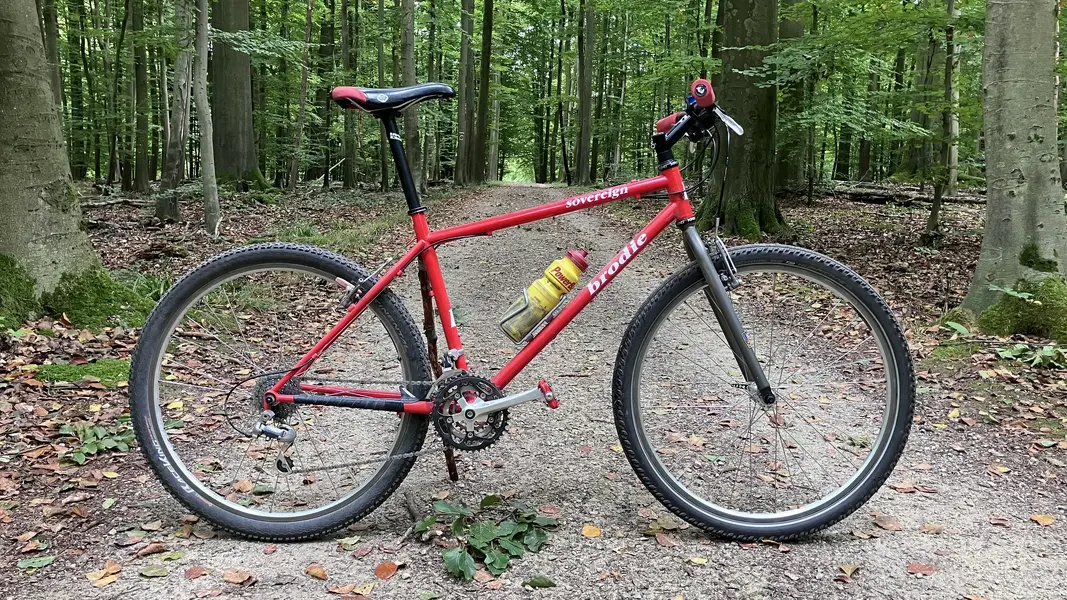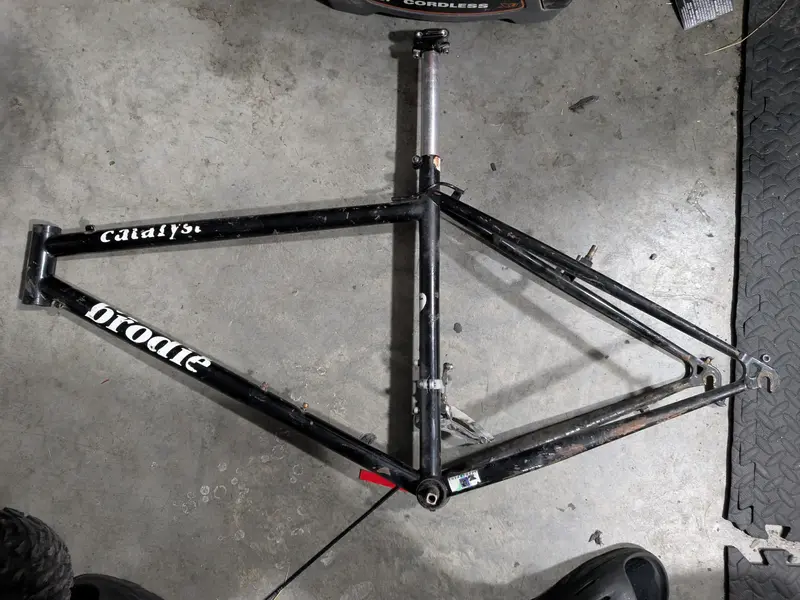You are using an out of date browser. It may not display this or other websites correctly.
You should upgrade or use an alternative browser.
You should upgrade or use an alternative browser.
Build thread - Brodie Sovereign '95
- Thread starter PanoIgano
- Start date
PanoIgano
Fat Chance Fan
Prodigal Son
Senior Retro Guru
It's only a matter of how you set them up.Haven’t been entirely satisfied with the braking performance of XTR cantis (maybe I didn’t set them up correctly either) so decided the following change:
View attachment 884518
View attachment 884519
As you can see for these pictures the angles these Ritchey / Dia Comp cantis have is bigger. This should increase the leverage of these cantis when pressing the rim.
Also the mounting of the breaking pads are on the back side of the cantilevers not on the front like Shimano ones. This brings the braking power closer to the fork and frame studs / pivots and should result in slightly less flex.
Still a stiffener will be needed at least on the rear brake..
Prodigal Son
Senior Retro Guru
This is it. Btw lower the straddle on the rear cause its too high. Braking will feel so much better you will forget seatstay flex.It looks like the XTR would have more leverage than the Ritchey Logic. Leverage would be measured in a straight line from the pivot point to where the cable is clamped/nipple is held.
You have a fixed straddle cable that makes tweaking the set-up of cantilevers limiting. If you had a traditional hanger with separate straddle cable you could drop the hanger very low to the tyre (without rubbing) to maximise leverage as you are pulling the brake arms more into the rim vs. if the the straddle cable is a lot higher as a lot of the pulling force is going upwards rather than sideways (into the rim).
If you pushed your pads inwards (you'd need to change to a separate straddle/hanger) you'd probably end up with a nicer angle to maximise leverage.
You can then also test/see how the feel of the brake changes at the lever from high position/low position on the cable hanger. High has less leverage so will feel firmer (less flex at the studs) and lower will feel sponger (more flex at the studs).
One thing to watch out for will be heel clearance on the rear brakes if they stick out too much!
Happy tinkering!
There is a hole in the fork so you can mount a cable hanger there. It's a special hanger but easy to findo on the web. No need for v brakes: well set cantis brake just fine.
Last edited:
rigidftw
Retro Guru
And properly adjusted V-brakes use less much lever force and offer superior modulation.This is it. Btw lower the straddle on the rear cause its too high. Braking will feel so much better you will forget seatstay flex.
There is a hole in the fork so you can mount a cable hanger there. It's a special hanger but easy to findo on the web. No need for v brakes: well set cantis brake just fine.
SCNR
PanoIgano
Fat Chance Fan
Got them grom Gill at retrodecals so if you are based in UK that's your best option I would say.Beautiful bike! Great build thread, thank you for sharing.
I have a 93'/94' i think. Catalyst serial #2854 that I am going to get re painted.
Where did you get your decals?
He should have in file the Catalyst ones too as he has an extensive archive of decals.
BTW, yours looks so cool! What color are you going to paint it in?
PanoIgano
Fat Chance Fan
I am not sure you guys are going to like this but I replaced the rear XTR cantis first with Ritchey and then with STX...And properly adjusted V-brakes use less much lever force and offer superior modulation.
SCNR
In the front, I really liked how the Avid Arch Rival 50s work. For me the biggest difference in break performance can be achieved by dialing in the combo of rims and pads, especially if you want great stopping power in wet conditions.
Of course you also need to set the Cantis correctly. No doubt at about that!
I am happy with the combo now as this is not a period correct build. I ride this bike the most so I just aimed for what works best.
BTW, I just realised I haven't even made a build list of the parts here...
PhillB
GT Fan
I've got STX brakes on one of my Breezers - they work really well!I am not sure you guys are going to like this but I replaced the rear XTR cantis first with Ritchey and then with STX...
In the front, I really liked how the Avid Arch Rival 50s work. For me the biggest difference in break performance can be achieved by dialing in the combo of rims and pads, especially if you want great stopping power in wet conditions.
Of course you also need to set the Cantis correctly. No doubt at about that!
I am happy with the combo now as this is not a period correct build. I ride this bike the most so I just aimed for what works best.
BTW, I just realised I haven't even made a build list of the parts here...
MattiThundrrr
Kona Fan
My favorite kind of build, done to make the rider happy, not to please internet viewers. Ironic I suppose, because you pleased an internet viewer with itI am happy with the combo now as this is not a period correct build. I ride this bike the most so I just aimed for what works best.
Also, STX's quality is highly underrated
Similar threads
- Replies
- 14
- Views
- 2K
- Replies
- 4
- Views
- 655

